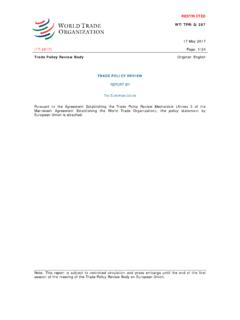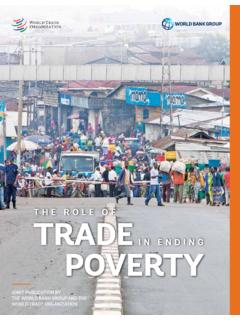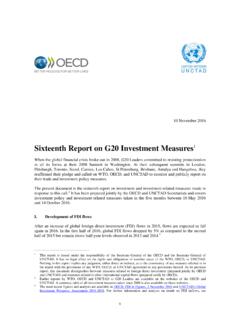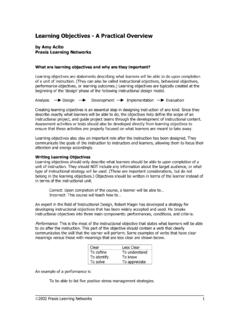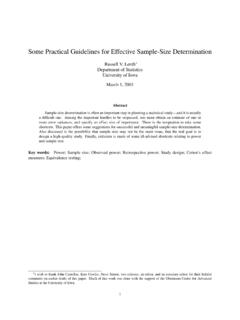Transcription of A Practical Guide to Trade Policy Analysis
1 A Practical Guide to Trade Policy AnalysisWhat is A Practical Guide to Trade Policy Analysis ? A Practical Guide to Trade Policy Analysis aims to help researchers and policymakers update their knowledge of quantitative economic methods and data sources for Trade Policy this Guide The Guide explains analytical techniques, reviews the data necessary for Analysis and includes illustrative applications and exercises. An accompanying DVD contains datasets and programme command files required for the out more Website: authors and acknowledgements 3 Disclaimer 4 Foreword 5 Introduction 7 CHAPTER 1: Analyzing Trade flows 11A.
2 Overview and learning objectives 13B. Analytical tools 14C. Data 34D. Applications 39E. Exercises 54 CHAPTER 2: Quantifying Trade Policy 61A. Overview and learning objectives 63B. Analytical tools 63C. Data 79D. Applications 84E. Exercises 93 CHAPTER 3: Analyzing bilateral Trade using the gravity equation 101A. Overview and learning objectives 103B. Analytical tools 103C. Applications 120D. Exercises 1312 CHAPTER 4: Partial-equilibrium Trade - Policy simulation 137A. Overview and learning objectives 139B.
3 Analytical tools 141C. Applications 162D. Exercises 172 CHAPTER 5: General equilibrium 179A. Overview and learning objectives 181B. Analytical tools 181C. Application 200 CHAPTER 6: Analyzing the distributional effects of Trade policies 209A. Overview and learning objectives 211B. Analytical tools 212C. Data 218D. Applications 221E. Exercise 2293 Contributing authorsMarc Bacchetta Economic Research and Statistics Division, World Trade OrganizationCosimo BeverelliEconomic Research and Statistics Division, World Trade OrganizationOlivier CadotUniversity of Lausanne, World Bank and Centre for Economic Policy Research Marco FugazzaInternational Trade in Goods and Services and Commodities Division, UNCTAD Jean-Marie GretherUniversity of Neuch telMatthias HelbleEconomic and Regulatory Affairs Directorate, International Bureau.
4 Universal Postal Union Alessandro NicitaInternational Trade in Goods and Services and Commodities Division, UNCTADR oberta PiermartiniEconomic Research and Statistics Division, World Trade OrganizationAcknowledgementsThe authors would like to extend their thanks to Patrick Low (WTO) and Vlasta Macku (UNCTAD Virtual Institute) for launching and supporting the project. They also wish to thank the staff of the Virtual Institute for organizing two workshops in which the material developed for this volume was presented. This material was also presented at a workshop organized as part of the WTO Chairs Programme at the University of Chile.
5 The interaction with the participants of these workshops was very helpful in improving the content of this book. Thanks also go to Madina Kukenova and Jos -Antonio Monteiro who provided valuable research assistance and Anne-Celia Disdier and Susana Olivares (UNCTAD Virtual Institute) for helpful comments. The production of this book was managed by Anthony Martin (WTO) and Serge Marin-Pache (WTO). The website and DVD were developed by Susana Olivares. 4 DisclaimerThe designations employed in UNCTAD and WTO publications, which are in conformity with United Nations practice, and the presentation of material therein do not imply the expression of any opinion whatsoever on the part of the United Nations Conference on Trade and Development or the World Trade Organization concerning the legal status of any country, area or territory or of its authorities, or concerning the delimitation of its frontiers.
6 The responsibility for opinions expressed in studies and other contributions rests solely with their authors, and publication does not constitute an endorsement by the United Nations Conference on Trade and Development or the World Trade Organization of the opinions expressed. Reference to names of firms and commercial products and processes does not imply their endorsement by the United Nations Conference on Trade and Development or the World Trade Organization, and any failure to mention a particular firm, commercial product or process is not a sign of book is the outcome of joint work by the Secretariats of UNCTAD and the WTO.
7 Its six chap-ters were written collaboratively by academics and staff of the two organizations. The volume aims to help researchers and Policy -makers expand their knowledge of quantitative economic methods and data sources for Trade Policy Analysis . The need for the book is based on the belief that good Policy needs to be backed by good Analysis . By bringing together the most widely used approaches for Trade Policy Analysis in a single volume, the book allows the reader to compare methodologies and to select the best-suited to address the issues of today.
8 The most innovative feature of the book is that it combines detailed explanations of analytical tech-niques with a Guide to the data necessary to undertake Analysis and accompanying tutorials in the form of exercises. This approach allows readers of the publication to follow the analytical process step by step. Although the presentations in this volume are mostly aimed at first-time practitioners, some of the most recent advances in quantitative methods are also covered. This book has been developed in response to requests from a number of research institutions and universities in developing countries for training on Trade Policy Analysis .
9 Despite the growing use of quantitative economics in Policy making, no existing publications directly address the full range of Practical questions covered here. These include matters as simple as where to find the best Trade and tariff data and how to develop a country s basic statistics on Trade . Guidance is also provided on more complicated issues, such as the choice of the best analytical tools for answering questions ranging from the economic impact of membership of the WTO and preferential Trade agreements to how Trade will affect income distribution within a country.
10 Although quantitative Analysis cannot provide all the answers, it can help to give direction to the process of Policy formulation and to ensure that choices are based on detailed knowledge of underlying realities. We commend this Guide to those engaged in creating Trade Policy and we hope that by contributing to the understanding of state-of-the-art tools for Policy Analysis , this Guide will improve the quality of Trade Policy -making and contribute to a more level playing field in Trade relations.




